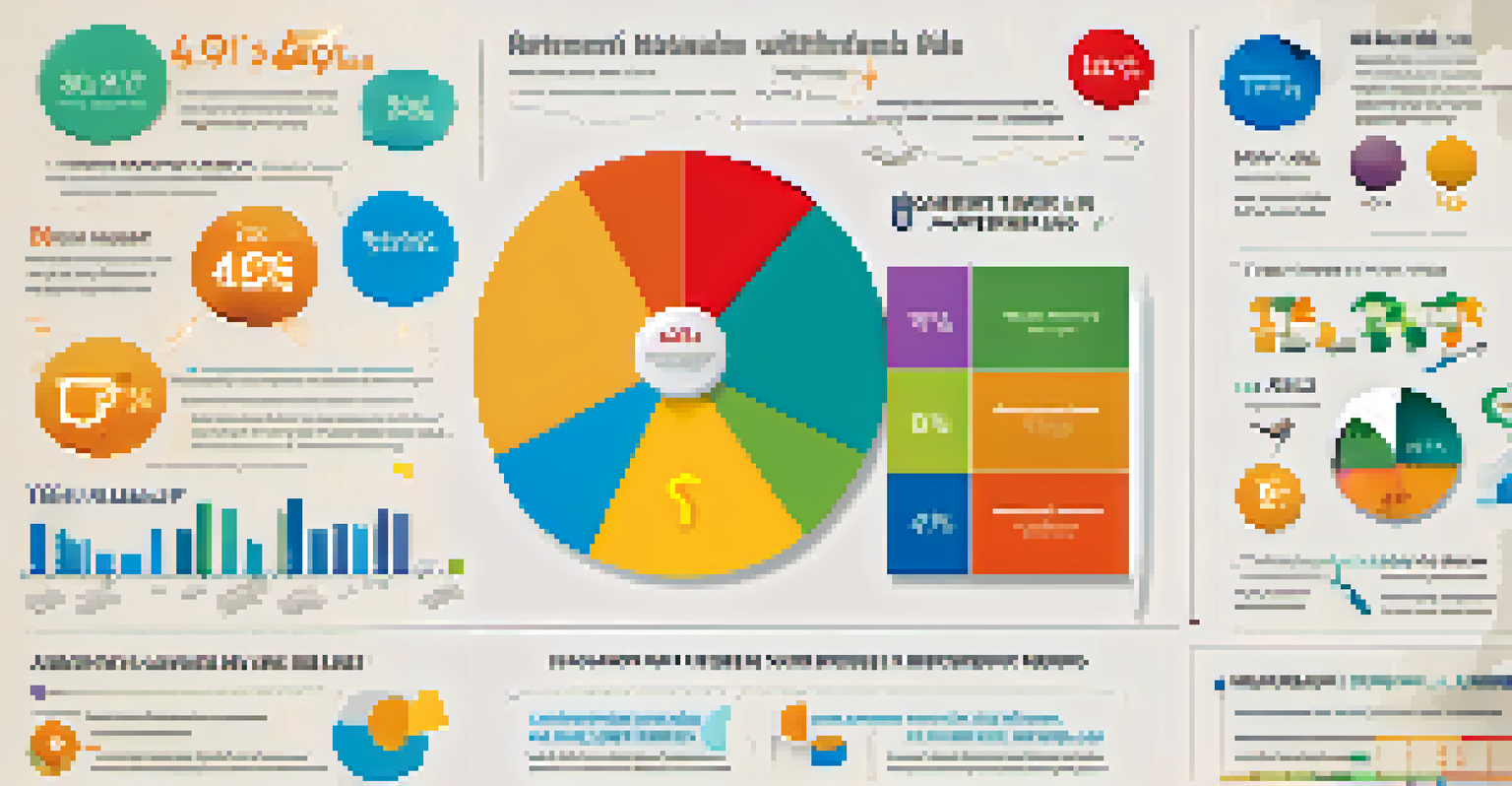Understanding the 4% Rule for Retirement Withdrawals

What is the 4% Rule and How Does It Work?
The 4% rule is a guideline used by retirees to determine how much they can withdraw from their retirement savings each year without running out of money. Essentially, it suggests that if you withdraw 4% of your initial retirement portfolio annually, adjusted for inflation, your savings should last for at least 30 years. This rule emerged from studies of historical market returns and aims to provide a simple framework for sustainable withdrawals.
In investing, what is comfortable is rarely profitable.
Imagine you've saved $1 million for retirement. According to the 4% rule, you would withdraw $40,000 in your first year. This amount would increase each subsequent year to keep pace with inflation, ensuring that your purchasing power remains intact. The beauty of this rule lies in its simplicity, making it easier for retirees to plan their finances without getting lost in complex calculations.
However, it's essential to remember that the 4% rule is not a one-size-fits-all solution. Individual circumstances, market conditions, and lifestyle choices can all impact how much you can safely withdraw. Therefore, while the 4% rule provides a solid starting point, it’s crucial to tailor your withdrawal strategy to fit your unique situation.
The Origins of the 4% Rule: A Brief History
The 4% rule originated from a study known as the 'Trinity Study,' conducted by researchers at Trinity University in the 1990s. This study analyzed various stock and bond market scenarios over a 30-year period to determine safe withdrawal rates for retirees. The findings indicated that withdrawing 4% annually would generally allow retirees to maintain their lifestyles without depleting their funds.

Think of the Trinity Study as a treasure map, guiding retirees toward financial security. By examining historical data, the study provided a formula that many people could follow to ensure their retirement savings would last. As a result, the 4% rule gained popularity and became a cornerstone of retirement planning strategies.
Understanding the 4% Rule
The 4% rule helps retirees determine a sustainable annual withdrawal rate from their retirement savings.
Since then, the rule has been widely discussed in financial circles and is often suggested by financial advisors as a safe withdrawal strategy. However, as with any financial principle, it’s vital to stay informed and adjust your approach based on current economic conditions and personal financial situations.
Benefits of Following the 4% Rule
One of the primary benefits of the 4% rule is its simplicity, which allows retirees to easily calculate their annual withdrawals without needing complicated financial software. This straightforward approach can reduce anxiety and help retirees feel more in control of their finances. Knowing you can withdraw a consistent percentage can provide peace of mind in an otherwise uncertain time.
The four most dangerous words in investing are: 'This time it's different.'
Additionally, the 4% rule promotes a disciplined saving and spending mindset. By setting a specific withdrawal rate, retirees are encouraged to stick to their budgets and manage their expenses more effectively. This discipline can lead to a more enjoyable retirement, free from the stress of financial uncertainty.
Moreover, the rule encourages retirees to consider their investment strategies carefully. By maintaining a diversified portfolio, retirees can potentially achieve returns that allow their savings to grow even while they withdraw funds. This balance between spending and investing is crucial for long-term financial health.
Limitations and Considerations of the 4% Rule
While the 4% rule is a helpful guideline, it’s important to recognize its limitations. One significant factor is that the rule is based on historical market performance, which may not accurately predict future returns. Economic conditions can change, and market downturns can impact your retirement savings, potentially making the 4% withdrawal rate unsustainable in the long run.
Another consideration is individual lifestyle and spending habits. Some retirees may have higher medical expenses or wish to travel more, which can significantly affect how much they need to withdraw annually. It’s crucial to assess your personal financial situation and adjust your withdrawal rate accordingly, rather than relying solely on the 4% rule.
Limitations of the 4% Rule
Factors like market performance, personal spending habits, and inflation can affect the effectiveness of the 4% rule.
Finally, inflation poses a risk to the 4% rule. Although the rule accounts for inflation by adjusting withdrawals, unexpected spikes in inflation can erode your purchasing power. Regularly reviewing your financial plan and making adjustments can help ensure that your retirement savings keep up with rising costs.
Adjusting the 4% Rule for Your Unique Situation
To make the 4% rule work for you, it's essential to evaluate your specific financial circumstances. Factors such as your overall savings, risk tolerance, and retirement lifestyle can influence how much you should withdraw. For some, a lower withdrawal rate may provide greater peace of mind and financial security.
For example, if you expect to live longer or have significant health expenses, you might consider withdrawing less than 4% to safeguard your savings. Alternatively, if you have a robust investment strategy and feel comfortable with market fluctuations, you may choose to withdraw a bit more. The key is to customize the rule to fit your unique needs and goals.
Additionally, consulting with a financial advisor can be beneficial. A professional can help you assess your financial situation and develop a withdrawal strategy that balances your needs with market realities. This personalized approach can help you navigate retirement more confidently and ensure your savings last.
Real-Life Examples of the 4% Rule in Action
Let’s consider two retirees, Sarah and John. Sarah follows the 4% rule strictly and withdraws $40,000 annually from her $1 million retirement portfolio. Meanwhile, John, a more cautious retiree, decides to withdraw only 3% or $30,000 to ensure he has a buffer in case of unexpected expenses. While both may feel secure, their different approaches highlight how the 4% rule can be adapted to individual risk tolerances.
In another scenario, imagine a retiree who has already experienced a market downturn early in retirement. If their portfolio value drops significantly, sticking to the 4% rule might not be feasible. Instead, they may need to adjust their withdrawal rate to preserve their savings during challenging market conditions. This flexibility is crucial for long-term financial sustainability.
Personalizing Your Withdrawal Strategy
It's crucial to tailor your withdrawal rate based on individual circumstances and financial goals for a secure retirement.
These examples showcase the importance of adapting the 4% rule to fit your personal circumstances. By considering factors like market conditions and individual financial goals, you can create a retirement withdrawal strategy that works for you, ensuring your golden years are as enjoyable and stress-free as possible.
Final Thoughts on the 4% Rule for Retirement Withdrawals
The 4% rule serves as a valuable starting point for retirement planning, offering a simple and effective way to determine withdrawals. However, it’s essential to remember that it’s not a rigid rule but rather a guideline that should be tailored to fit your unique situation. By considering personal factors and staying informed about market trends, you can ensure your retirement savings last.
As you approach retirement, take the time to evaluate your financial situation and create a flexible withdrawal strategy. This proactive approach will help you adapt to changing circumstances and avoid the pitfalls associated with rigid withdrawal rates. Ultimately, your goal should be to maintain a comfortable lifestyle while securing your financial future.

In conclusion, the 4% rule can provide a solid foundation for retirement withdrawals, but always be prepared to adjust as life unfolds. A thoughtful, personalized approach will help you navigate the complexities of retirement, allowing you to enjoy this rewarding phase of life with confidence and peace of mind.